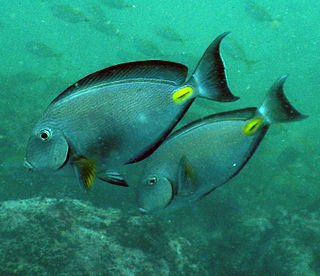 W
WAcanthurus monroviae, also known as the Monrovia doctorfish, is a tropical fish which is widespread in the eastern Atlantic Ocean and is also known from a number of records in the Mediterranean Sea. Vagrants have also been reported from the coast of Brazil. It is present in some commercial fisheries, and is also used in aquariums. It was described by Franz Steindachner in 1876.
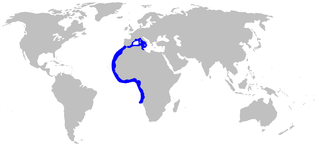 W
WThe sawback angelshark is an angelshark of the family Squatinidae
 W
WThe smoothback angelshark is an angelshark of the family Squatinidae found in the eastern Atlantic.
 W
WThe cardinalfish, also known as the Mediterranean cardinalfish or king of the mullets, is a species in the family of Apogonidae (cardinalfishes). It is widely distributed in the Mediterranean and along the warm temperate and tropical eastern Atlantic coasts from Portugal south to the Gulf of Guinea.
 W
WThe African sawtail catshark is a species of catshark, part of the family Scyliorhinidae. Demersal in nature, it is found at depths of 160–720 m (520–2,360 ft) off the western African coast from Morocco to South Africa. This slender species has a rather long, pointed snout, a series of dark saddles along the back and tail, and a prominent crest of enlarged dermal denticles along the upper edge of the caudal fin. Its maximum known length is 46 cm (18 in).
 W
WThe West African catshark is a catshark of the family Scyliorhinidae. It is found in the eastern Atlantic between latitudes 20° N and 17° S, at depths between 45 and 500 m. It can grow up to a length of 80 centimetres (31 in). At one time, the West African catshark was considered to be a subspecies of the nursehound, Scyliorhinus stellaris, but is now considered to be a separate species. The reproduction of this catshark is oviparous.
 W
WChilomycterus antennatus, the bridled burrfish, is a species of fish belonging to the family Diodontidae. It is native to the tropical waters of the Western Atlantic from southeastern Florida and the Bahamas to northern South America. They are also found in the Eastern Atlantic off the cost of Mauritania.
 W
WThe annular sea bream is a species of seabream belonging to the family Sparidae.
 W
WThe leopard eel is an eel in the worm or snake eels family, Ophichthidae. It was described by Achille Valenciennes in 1839, originally under the genus Ophisurus.
 W
WThe dark moray eel is a moray eel found in the eastern Atlantic Ocean, from Mauritania to Cape Frio, Namibia. It was first named by Marcus Elieser Bloch in 1795,.
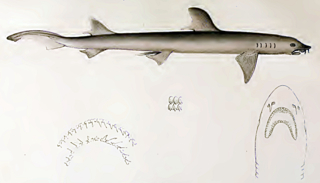 W
WThe barbeled houndshark is a species of ground shark and the only member of the family Leptochariidae. This demersal species is found in the coastal waters of the eastern Atlantic Ocean from Mauritania to Angola, at depths of 10–75 m (33–246 ft). It favors muddy habitats, particularly around river mouths. The barbeled houndshark is characterized by a very slender body, nasal barbels, long furrows at the corners of the mouth, and sexually dimorphic teeth. Its maximum known length is 82 cm (32 in).
 W
WThe longfin crevalle jack is a recently described species of large marine fish classified in the jack family, Carangidae. It inhabits the subtropical waters of the east Atlantic Ocean, ranging along the African coast from Mauritania south at least to Moçamedes in southern Angola, with the species historically present in the Mediterranean Sea. It is an inshore species, known to occasionally penetrate estuaries, possibly to spawn. The species is very similar to the crevalle jack, Caranx hippos, and is separated by its extended dorsal and anal fin lobes as well as more detailed anatomical features including dorsal and anal fin ray counts. The fish is known to reach 127 cm in length and 20.9 kg in weight. The longfin crevalle jack is a predatory fish, taking small fish as its main prey. Due to longstanding confusion between C. fischeri and C. hippos, the importance of each species to African fisheries is poorly understood, with a known combined catch in this region of between 2,233 and 10,054 tonnes per year in 1995–2004. Like its close relatives, the species is considered a powerful gamefish and highly sought after, although their coarse flesh makes for relatively poor quality food.
 W
WThe Senegal jack, also known as the African jack, is a species of large marine fish classified in the jack family Carangidae. The species is distributed through the tropical waters of the eastern Atlantic Ocean, ranging along the west African coast from Angola in the south to Mauritania in the north. It can be distinguished from co-occurring relatives by its longer dorsal fin lobe, as well as a host of other anatomical features. The Senegal jack grows to a known maximum length of 1 m. It is a coastal species, known to live semi-pelagically, inhabiting both the sea floor and surface waters to depths of around 200 m. The Senegal jack is a predatory species, taking fish, crabs and shrimps as its main prey items. The species reaches sexual maturity at 21 cm in females and 24 cm in males, with spawning occurring in two periods; February to April and September to November. The species is of minor importance to fisheries, and is not discriminated from other jacks in catch statistics. It is taken by trawls, seines and hook and line, and sold fresh or preserved.
 W
WThe West African ladyfish is a species of fish in the family Elopidae. It is native to the coastal waters of the eastern Atlantic Ocean, from Senegal to Angola. It is also known as the Guinean ladyfish. Some have been known to grow to 20 lb.
 W
WThe leerfish or garrick is a species of marine fish in the family Carangidae, and is native to the Mediterranean and the coastal waters of western Africa to the coastal waters of eastern South Africa. Also recorded in the Black Sea. These fish can reach 1.5 m in length and more than 30 kg in weight. They inhabit the coastal wave zone where they form small shoals to hunt other smaller fish, favouring mullets.
 W
WThe Atlantic mudskipper is a species of mudskipper native to fresh, marine and brackish waters of the tropical Atlantic coasts of Africa, including most offshore islands, through the Indian Ocean and into the western Pacific Ocean to Guam. The Greek scientific name Periophthalmus barbarus is named after the eyes that provide the Atlantic mudskipper with a wide field of vision. The Atlantic mudskipper is a member of the genus Periophthalmus, which includes oxudercine gobies that have one row of canine-like teeth.
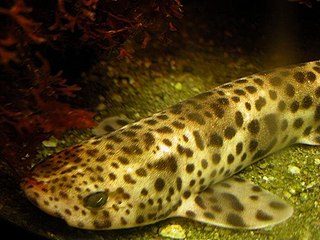 W
WThe nursehound, also known as the large-spotted dogfish, greater spotted dogfish or bull huss, is a species of catshark, belonging to the family Scyliorhinidae, found in the northeastern Atlantic Ocean. It is generally found among rocks or algae at a depth of 20–60 m (66–197 ft). Growing up to 1.6 m (5.2 ft) long, the nursehound has a robust body with a broad, rounded head and two dorsal fins placed far back. It shares its range with the more common and closely related small-spotted catshark, which it resembles in appearance but can be distinguished from, in having larger spots and nasal skin flaps that do not extend to the mouth.
 W
WThe striped panray is a species of ray in the family Zanobatidae. It was considered the only species in its genus and family until the description of the maculate panray in 2016.
 W
WThe round sardinella is a species of ray-finned fish in the genus Sardinella found in both sides of the Atlantic Ocean and the Mediterranean Sea.
 W
WThe false scad, also known as the spotfin scad, ten-finned horse mackerel and yellow horse mackerel, is a species of medium-sized marine fish classified in the jack family Carangidae. The false scad is distributed throughout the tropical and temperate waters of the eastern Atlantic Ocean from Namibia in the south to Spain and throughout most of the Mediterranean in the north. The species has an atypical body form compared to other species of Caranx, and can be distinguished from these on its elongate 'scad-like' body shape alone. Distinguishing the species from members of Decapterus and Trachurus is more difficult, requiring detailed anatomical analysis. The false scad is known to grow to a length of 60 cm and a weight of 1 kg. The species lives both pelagically and demersally in continental shelf waters, ranging from depths of 15 to 200 m. It is a predatory fish, taking small fishes, crustaceans including euphausiids and shrimps, and cephalopods as its main prey, with significant dietary shifts as it ages. The false scad reaches sexual maturity at 2 years of age, with spawning occurring between April and July in shallow inshore waters, where the juveniles remain. The species is of major importance to fisheries throughout its range, but particularly from Morocco to Senegal, with annual catches ranging from 500 to 19000 t. The species is caught using trawls, seine nets and gill nets and sold fresh, frozen or salted.
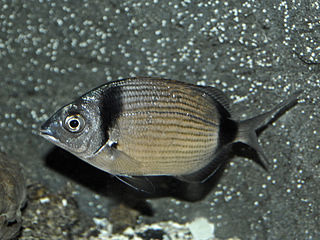 W
WThe common two-banded sea bream is a species of seabream belonging to the family Sparidae.
 W
WThe zebra sea bream is a species of seabream belonging to the family Sparidae.
 W
WThe lemon shark is a species of shark from the family Carcharhinidae. Lemon sharks can grow to 3.4 metres (11 ft) in length. They are often found in shallow subtropical waters and are known to inhabit and return to specific nursery sites for breeding. Often feeding at night, these sharks use electroreceptors to find their main source of prey: fish. Lemon sharks enjoy the many benefits of group living such as enhanced communication, courtship, predatory behavior, and protection. This species of shark gives birth to live young, and the females are polyandrous and have a biennial reproductive cycle. Lemon sharks are not thought to be a large threat to humans. The lemon shark's life span is unknown, but the average shark is 25 to 30 years old.
 W
WThe milk shark is a species of requiem shark, and part of the family Carcharhinidae, whose common name comes from an Indian belief that consumption of its meat promotes lactation. The largest and most widely distributed member of its genus, the milk shark typically measures 1.1 m (3.6 ft) long, and can be found in coastal tropical waters throughout the eastern Atlantic and the Indo-Pacific regions. Occurring from the surface to a depth of 200 m (660 ft), this species is common near beaches and in estuaries, and has been recorded swimming up rivers in Cambodia. Juveniles are known to inhabit tidal pools and seagrass meadows. The milk shark has a slender body with a long, pointed snout and large eyes, and is a nondescript gray above and white below. This shark can be distinguished from similar species in its range by the long furrows at the corners of its mouth, and seven to 15 enlarged pores just above them.
 W
WThe night shark is a species of requiem shark, in the family Carcharhinidae, found in the temperate and tropical waters of the Atlantic Ocean. An inhabitant of the outer continental shelf and upper continental slope, this shark most commonly occurs at depths of 50–600 m (160–1,970 ft) and conducts a diel vertical migration, spending the day in deeper water and moving into shallower waters at night. Off northeastern Brazil, large numbers congregate around seamounts of varying depths. A slender, streamlined species, the night shark typically reaches a length of 2 m (6.6 ft). It can be identified by its long, pointed snout and large, green eyes, and is dark grayish blue or brown above and white below.
 W
WThe pigeye shark or Java shark is an uncommon species of requiem shark, in the family Carcharhinidae, found in the warm coastal waters of the eastern Atlantic and western Indo-Pacific. It prefers shallow, murky environments with soft bottoms, and tends to roam within a fairly localised area. With its bulky grey body, small eyes, and short, blunt snout, the pigeye shark looks almost identical to the better-known bull shark. The two species differ in vertebral count, the relative sizes of the dorsal fins, and other subtle traits. This shark typically reaches lengths of 1.9–2.5 m (6.2–8.2 ft).
 W
WThe African threadfish, also known as the Alexandria pompano, is a species of large marine fish in the jack family, Carangidae. The species is distributed along the coast of tropical Africa in the eastern Atlantic Ocean, extending to the Mediterranean Sea. Adults live predominantly in shallow waters shallower than 70 m deep, often forming small schools. The African threadfish is similar in appearance to the closely related and co-occurring African pompano, with the slightly concave shape of the species head profile the most definitive feature of the species. Like other members of the genus Alectis, the juveniles of the species have long trailing dorsal and anal fins. The African threadfish is of minor commercial importance, and is also considered to be a game fish.
 W
WTrachinotus ovatus, the pompano which is also known as the derbio or silverfish, is a species of ray-finned fish in the family Carangidae, the jacks. It has large, strong fins. It is common in the Mediterranean Sea, and in the Atlantic Ocean from the British Isles and Scandinavia, where it is a vagrant, to the Gulf of Guinea and Angola.